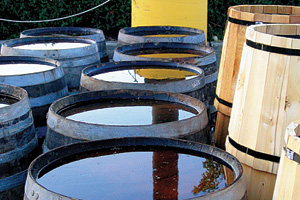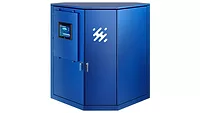Rain, Rain, can I use you again?
Rainwater catchment systems do require periodic maintenance.


|
| Photo credit: Jan Tik |
I had an interesting question from my beautiful wife, “Do you want a rain barrel?”
My answer was an emphatic “No!”
Of course, knowing my support of rainwater reuse, she was surprised I didn’t want a few barrels for our house. I had to explain to her that barrels in the Midwest are a joke. The first storm will fill the barrel. Then what happens with the next storm? In simple terms, a barrel is inadequate.
I asked, “What am I supposed to do with the water in the barrel?”
That is not to say I don’t support the use of rainwater barrels in parts of the country. I do. It is simply that in the Midwest, our rain comes down with force and with plenty of water. Many storms have left my backyard with 6 in. of accumulation.
If I were to install a rainwater harvesting system in my house, I would need a much larger storage tank than a barrel. One of the systems I installed in Chicago had a storage capacity of 10,000 gal. Of course, this was for a high-rise building and the water was used for irrigation. Today, we can use the water to flush water closets or urinals, as well as for irrigation.
The Chicago system was designed based on the anticipated rainfall for the area and the needs for the irrigation system. Once it was determined that a 10,000 gal. tank was needed, the next decision was where to install the tank. I chose the bottom level of the parking garage. That didn’t go over too well. The developer mentioned that each parking space is a condo space selling for $40,000. Hence, my rainwater collection system just got very expensive.
We made a change by installing the tank under the ramp in the parking garage. It was a weird-shaped tank, but by saving the parking spaces, the developer could afford to pay a little extra.
You may be asking, “How do I know what size tank to install?” There is a new standard available from ASPE on that very subject. The standard is ASPE 63, Rainwater Catchment. The standard lists what you need to consider when sizing and locating a rainwater catchment storage tank. I would encourage you to buy a copy of the standard.
Maintenance issues
One of the simplest ideas is to bury the tank. That sounds easy, but sometimes it is not so easy. The one thing you need to remember is that a rainwater harvesting system requires maintenance. It is a little more difficult to maintain an underground storage tank. It is possible; you just need to take that into consideration when designing and installing the system.
Which leads me to the problem of maintenance. Rainwater harvesting is a wonderful idea. I like it, I promote it and I have some experience with installing it. You need to be honest and up front with clients when discussing any rainwater harvesting system. It willrequire maintenance.
Most people are spoiled with plumbing systems. The same is true with most irrigation systems. You install them and you forget about them. There really isn’t a tremendous amount of maintenance when you are using potable water.
The same is not true for a rainwater harvesting system. Maintenance is required at a yearly cost. The owner of the building becomes responsible for the maintenance. While he may be gung ho for going green today, he may change his mind in a few years.
The more involved the system, the higher the maintenance cost. For example, if you decide you want to flush water closets with rainwater, you probably will have a high maintenance cost. The water must be treated as well as periodically tested. Again, this costs money.
If you combine rainwater with graywater, additional costs are involved. Again, I am not discouraging you from considering rainwater harvesting. I simply want you to prepare your customer for what is involved. I would still highly recommend promoting the green aspect of rainwater harvesting.
The easiest, most basic system is a rainwater barrel. It also requires the least amount of maintenance. However, to use it, you may be dipping a watering can into the barrel. At least, that is what my father-in-law used to do with his rainwater. He loved watering his garden. He didn’t want any piping to his collection barrel. It was very simple and basic. But it was green and he loved using it. I was surprised when he didn’t install a rainwater harvesting system in his retirement house. He told me he was getting older and a hose sounded better.
All rainwater harvesting systems need piping to the storm sewer for when the collection tank is full. Then the system converts to a normal storm drainage system. If it is a barrel, the water just comes out the overflow. For larger systems, such as the one installed in Chicago, a piping system serves as a bypass when the tank is full.
In the spring, it is not unusual for the tank to fill early in the season. For the remainder of the spring storms, the bypass works. You can’t get greedy and try to collect all the rainwater. The size of the tank for many parts of the country would simply be too large.
The system installed in Chicago was one of the first rainwater harvesting systems in the city. Civic leaders were excited about the installation. So was I. You may be asking, “How has it done?”
I ran into the project architect about a year ago. I decided to ask. I figured he was still in contact with the building owner. He told me that the system worked great for the first five years. Then the owner realized he was paying for the maintenance. As a result, he decided to abandon the rainwater harvesting system and convert to watering with potable water. For the last seven years, the system has been in mothballs.
Oh well, that can happen. All you can do is say that you gave your customer a wonderful green system. It is the owner’s decision as to whether it will continue to be green.
HELPFUL LINKS:
Looking for a reprint of this article?
From high-res PDFs to custom plaques, order your copy today!







